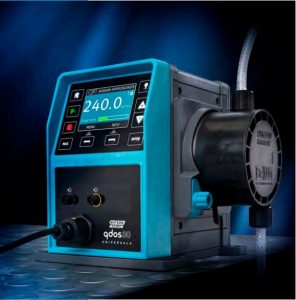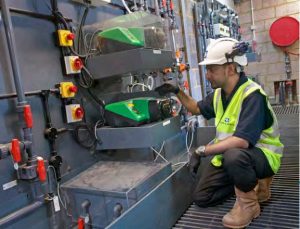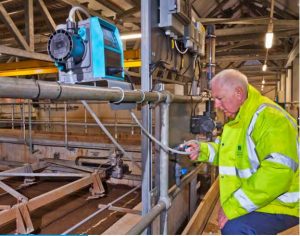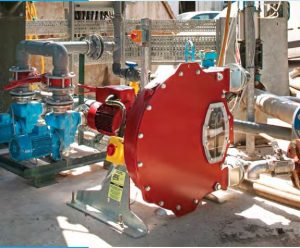Introduction
Over the past few months, signals have been emanating from Brussels that hint at tighter wastewater treatment regulations. For instance, not only has Carlos Moedas, EU Commissioner for Research, Science and Innovation, recently been calling for better treatment systems for wastewater, but former Environment Minister, Janez Potočnik, has backed a Friends of the Earth report lobbying for improvements on water reporting and pollution.
 In the wake of changes to EU wastewater treatment legislation, the right preparation and early investment in accurate chemical metering makes commercial sense.
In the wake of changes to EU wastewater treatment legislation, the right preparation and early investment in accurate chemical metering makes commercial sense.
Both municipal and industrial wastewater processors must take heed Better chemical metering is an important step in that process.
Punitive measures
Time is of the essence regarding this increasingly urgent matter, as a number of recent actions indicate. Since March of this year, the EU Commission has taken France to court over non-compliance with legislation on urban wastewater treatment, and asked Poland to bring its national laws on groundwater protection into line with the Groundwater Directive.
Put simply, recent EU documents on water policy contain key recommendations that encourage action on industrial plants and pollution. History shows that such recommendations and encouragements are often precursors to law.
Undercurrent of change
Clearly, there is an undercurrent of change with regard to wastewater and its associated treatment, for both municipal and industrial processes. As with all change, the trick is to make improvements ahead of the game, which means that water companies, the treatment chain and industrial water users, need to start thinking about correct and thorough preparation, as well as investment in the right technology. Better treatment of wastewater, through improved chemical metering technologies, is among the primary way to help.
Better chemical metering is important for many reasons. For example, to help reduce operational expenditure, higher concentrations of chemicals are being used by plants to help reduce transportation, handling and storage costs. This increases the demands on metering pumps for higher accuracy, higher viscosities and greater chemical compatibility. As a result, the inherent precision and performance attributes of the latest peristaltic chemical metering pumps are proving increasingly popular.
Compatible technology
Beyond precision, an increase in chemical concentration requires the pump fluid contact materials to have stronger chemical resistance. Although this can prove problematic to many pump types, in peristaltic metering pumps, nothing but the tube touches the fluid, eliminating the risk of the pump contaminating the fluid, or the fluid contaminating the pump. This also makes this pump type ideal for high concentration or aggressive chemicals.
The absence of ancillaries, such as back-pressure valves, pulsation dampeners, degassing valves, foot valves, strainers and float switches, all of which are typically required to support a diaphragm pump installation, is another major benefit. As a result, peristaltic metering pumps, which instead feature a single piece pumphead, offer simpler configuration, reduced spares inventory and lower total cost of ownership (TCO).
The Togliatti, Russia plant of steel wheel manufacturer, Mefro Wheels, has opted to use the latest Qdos 30 metering pumps at the facility’s water treatment unit. As well as featuring patented ReNu pumphead technology, which is fully contained for safe, tool-free maintenance, the pump’s metering accuracy clearly caught the eye of Mefro engineers.
“When compared with some manufacturers of metering pumps, including diaphragm types, we were surprised by the high accuracy characteristics declared in the brochure,” says a Mefro spokesman. “However, following operational measurements, these characteristics were substantiated completely.” The Qdos 30 pumps have now been running at Togliatti for over six months. “It is particularly gratifying that no ReNu pumpheads have been replaced for the entire period of being in service, despite almost constant operation since the time of commissioning,” concludes the spokesman.
Maintaining excellence
Maintenance remains a key driver in the water treatment market. With the recent recession and economic conditions that remain challenging, many plants have seen budgets squeezed. As a consequence, there has been reduced spend on infrastructure and operations, which has led to poorly maintained facilities without adequately trained staff to repair them. This makes switching to peristaltic metering pumps – which unlike gear pump, piston or diaphragm pumps commonly used for chemical metering, feature no expensive seals, valves, diaphragms or rotors to leak, clog or corrode – a shrewd business move
Peristaltic metering pumps score well against other pumps types in a number of performance areas. For instance, while a typical diaphragm metering pump offers a flow range of 100:1, this is expanded to 875,000:1 with a peristaltic pump. What’s more, the accuracy of a peristaltic pump is 0.5% in comparison with the 5% accuracy of a typical solenoid pump. Chemicals are not cheap, hence accuracy can be enormously beneficial in terms of saving costs. Consider this; to reduce the cost of transporting chemicals, more and more companies are using higher concentrations. For example, calcium hydroxide in suspension is normally offered at 18%; but to be competitive on transportation, this is being increased to 45% in the UK. Higher concentrations require greater accuracy to ensure that chemicals are not over or under-metered.
 A 520DuN/REM peristaltic pump from WMFTG has met the immediate needs of three chemical dosing schemes implemented recently at various Severn Trent Water facilities. Deployed as part of a temporary dosing rig constructed by engineering group, Costain, the three schemes to date have seen the peristaltic pump used for ferrous chloride and ferric sulphate dosing.
A 520DuN/REM peristaltic pump from WMFTG has met the immediate needs of three chemical dosing schemes implemented recently at various Severn Trent Water facilities. Deployed as part of a temporary dosing rig constructed by engineering group, Costain, the three schemes to date have seen the peristaltic pump used for ferrous chloride and ferric sulphate dosing.
“In my mind there are so many things that can go wrong with a metering pump,” says Paul Pearson, Process Commissioning Engineer at Costain. “But with peristaltic, the potential for failure is reduced massively because there are no valves, stators, diaphragms, seals or glands. It makes maintenance extremely straightforward. Only the tubing requires replacement, which is quick and inexpensive, and provided this is done at the recommended intervals, there won’t be any problems. We’ve certainly had no issues so far.”
Added value
Boosting the added value offer, peristaltic pumps do not require pumped fluid to be continually present, which means the pumps can run dry without costly downtime or repairs. Furthermore, the recovery of the tube as part of its operating principle creates a powerful self-priming action that allows the pumps to move liquids containing entrapped air. Peristaltic metering pumps also offer reversible action, so if a blockage should occur it can be cleared at the flick of a switch.
In general, smarter water management and pumping technologies represent the optimum strategy for treatment facilities moving forward. This is because water is on course to be scarcer than oil by 2030, with demand outstripping water supply by 40%. Close to half the world’s population will be living in water stressed areas. And yet wastewater reuse stands at just 2.4% of all water withdrawals globally. Public attitudes to wastewater reuse will need to change, with greater levels of chemical metering becoming a necessity.
Applied solutions
Among common water treatment applications is disinfection using chemicals such as sodium hypochlorite, which is known to create gas locking and crystallisation in diaphragm pumps. When metering disinfectant, flow rates and pressure changes can fluctuate, impacting metering accuracy. Diaphragm pumps are often set to ‘over-dose’ to ensure water quality is maintained as they are frequently not accurate below 30% of their peak flow. For sodium hypochlorite this “over-dosing” usually results in excessive levels chlorine which need to be subsequently removed, thus increasing the quantity of de-chlorination chemicals required. In contrast, class-leading peristaltic pumps deliver predictable, accurate metering at variable pressure, even in fluctuating process conditions. Gas locking and crystallisation issues are also eliminated.
A related industrial water treatment process is pH adjustment, as water pH influences the effectiveness of disinfection. Furthermore, accurate pH control is critical to meet water standards and ensure process continuity. However, metering alkalis such as calcium hydroxide, or lime slurry, creates issues with mechanical damage to the pumps due to the abrasive nature of the chemical, while metering acids carries safety implications and can corrode pipework and equipment. Conversely, peristaltic pumps minimise pH ‘overshoot’. In addition, suspended solids are handled with no risk of clogging.
Reagent dosing
 High accuracy to optimise yields is a prerequisite in applications such as reagent dosing. Here, peristaltic metering pumps deliver linear and accurate metering across the flow range, improving the efficiency of flotation cells and increasing mineral yields.
High accuracy to optimise yields is a prerequisite in applications such as reagent dosing. Here, peristaltic metering pumps deliver linear and accurate metering across the flow range, improving the efficiency of flotation cells and increasing mineral yields.
Reagents such as sulphuric acid are hazardous and can damage pumps, but the use of modern pumphead technology on peristaltic models ensures safe containment.
Flocculation
Many plants use diaphragm pumps to perform flocculation, The use of common clarifying agents such as ferric chloride can lead to clogging – an unwanted effect that increases both maintenance and process downtime. Moreover, environmental conditions such as temperature, affect fluid viscosity and consequently diaphragm pump performance.
In fact, most diaphragm pumps struggle to pump viscosities of 2500 cP or more. Typically, flow must be reduced to 25% and the system designed sufficiently to achieve accurate performance. Conversely, the latest peristaltic pumps deliver accurate metering even with fluctuating viscosity, while their powerful suction capability eliminates the need for a day tank or specialist piping schemes.
 Convenience food manufacturer, Greencore Group Plc, achieved significant savings in downtime and repair costs on the water treatment plant at its Greencore Grocery site in Selby, North Yorkshire, thanks to the installation of a Bredel 50 high pressure hose pump. The Bredel 50 is used for dosing a magnesium hydroxide solution [Mg(OH)2] that helps correct fluctuations in pH levels caused by food effluent, resulting from frequent wash-downs. Switching from a ‘budget’ dosing pump to the Bredel model means there are no longer any abrasion issues leading to downtime or repair, thus reducing costs. According to Greencore Group, the pump “paid for itself extremely quickly”.
Convenience food manufacturer, Greencore Group Plc, achieved significant savings in downtime and repair costs on the water treatment plant at its Greencore Grocery site in Selby, North Yorkshire, thanks to the installation of a Bredel 50 high pressure hose pump. The Bredel 50 is used for dosing a magnesium hydroxide solution [Mg(OH)2] that helps correct fluctuations in pH levels caused by food effluent, resulting from frequent wash-downs. Switching from a ‘budget’ dosing pump to the Bredel model means there are no longer any abrasion issues leading to downtime or repair, thus reducing costs. According to Greencore Group, the pump “paid for itself extremely quickly”.
Higher flow or higher viscosity?
For applications where extremely high flows or product viscosity are present, robust hose pumps can provide the solution. Market leading hose pumps deploy heavy duty bearings within the pump rotor, eliminating overhung load. In addition, high torque gearing aligns directly to the pump housing and is protected by a buffer zone. Among the key features of hose pumps are: suitability for high viscosity and/or high flow applications; suction lift capability to 9 metres; dry running and self-priming; simple design; no slippage (allowing true positive displacement for accurate and repeatable metering); no ancillary equipment; and full reversing capability to blow out suction and drain lines safely.
Pre-empt change – and start saving now
With the tides of change clearly beginning to shift in regard to wastewater regulations, organisations and companies should grasp the chance to improve performance. In the first instance, getting ahead of potentially tighter legislation can provide a certain level of futureproofing. Secondly, it can save money when competitor organisations are later rushing to install the systems required to catch up. In short, there’s no sense in waiting; embedding the best wastewater treatment systems not only begins to save money immediately, it pre-empts changes and places businesses in a better position to win new contracts.





Comments